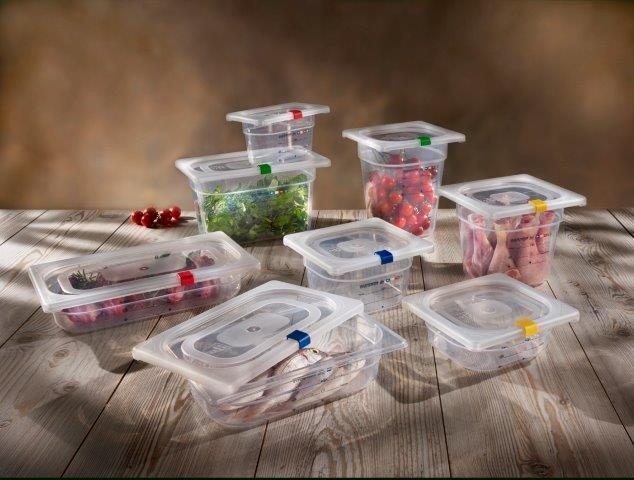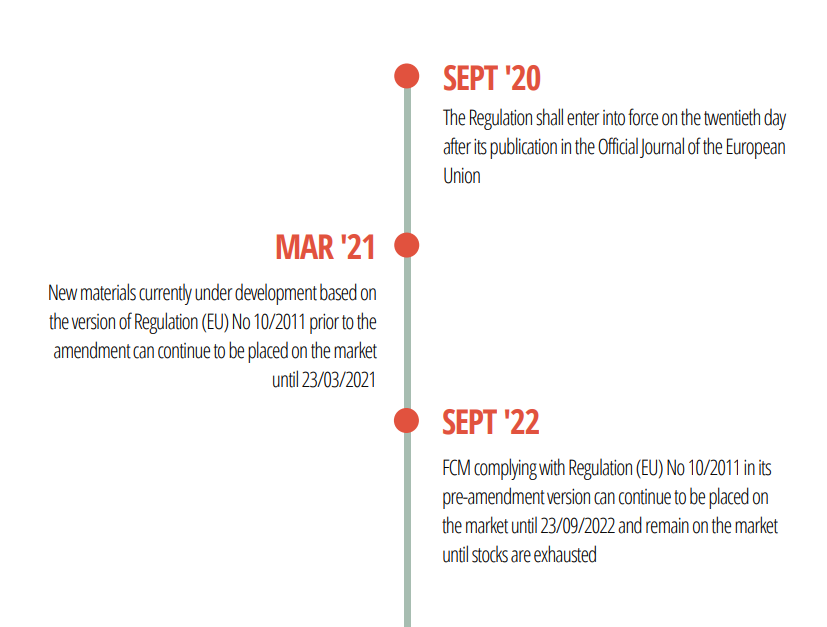NEUHEITEN

10 Dezember 2021
Plastic FCMs: what changes with the new EU regulation?
From 23 September 2022, plastic FCMs (plastic materials and articles intended to come into contact with food) that do not comply with the new Regulation (EU) No 2020/1245, which amends and corrects Annexes I, II, IV and V of Regulation (EU) No 10/2011, will no longer be allowed to be placed on the market: let’s find out the main changes

AUTHORISED PLASTIC MATERIALS
The list of authorised substances in Annex I for the manufacture of plastic articles intended for food contact has been implemented.
GLOBAL AND SPECIFIC MIGRATION FOR PLASTIC FCMs
If the material or article is intended to come into repeated contact with foodstuffs, the migration tests shall be carried out three times on one sample using a new portion of food simulant each time.
In addition, the migration in the second test shall not exceed the level observed in the first test and the migration in the third test shall not exceed the level observed in the second test.
M1 > M2 > M3
The compliance of the material or article shall then be verified on the basis of the level of migration found in the third test and the stability of the material or article between the first and the third migration test; if an increase in specific migration is observed from the first to the third migration step, even if lower than the specific limit (SML), the test shall be considered as NOT compliant.
TEST CONDITIONS FOR PLASTIC FCMs
The test condition OM0 has been added to Table 3 ‚Standardised test conditions for global migration‚.

METALS
The metals subject to restrictions are specified in Annex II. The new regulation increases the number of metals from 9 (aluminium, barium, cobalt, copper, iron, lithium, manganese, zinc and nickel) to 19.
The metals added are:
- Antimony
- Arsenic
- Cadmium
- Chromium
- Lead
- Mercury
And some lanthanides[1] whose sum must not exceed 0.05 mg/Kg:
- Europium
- Gadolinium
- Lanthanum
- Terbium
PRIMARY AROMATIC AMINES (PAA)
Regulation 10/2011 stated that no PAAs should be released, except for those listed in Table 1 of the Annex, and that the sum of these should not exceed 0.01 mg/Kg.
Under the new regulation, the limit for each amine, as listed in Annex XVII of Regulation (EC) No 1907/2006 (REACH), is now set at 0.002 mg/Kg.
For those PAA not listed in Annex XVII for which no specific migration limit is given in Annex I of Regulation (EU) No 10/2011, the sum of these PAA shall not exceed 0.01 mg/kg in the food or food simulant.
DECLARATION OF COMPLIANCE: WHAT CHANGES FOR PLASTIC FCMs?
In the intermediate stages of the supply chain, in the DoC, it is mandatory to include information regarding identification and quantity of substances in the intermediate material whose genotoxicity has not been excluded, which result from intentional use during a manufacturing step and which are potentially present in quantities that could be expected to result in migration from the finished material of more than 0.00015 mg/Kg of food or food simulant.
WHAT IS MORI 2A DOING ABOUT IT?
Mori 2A has already taken steps to carry out the migration tests again at the accredited reference laboratory. For more information on our quality management system, visit our website https://www.mori2a.com/en/conformity/
[1]Collective name for the chemical elements that follow lanthanum (La) in the periodic table, up to lutetium (Lu). The lanthanides therefore have atomic numbers ranging from 57 (La) to 71 (Lu) and are, in addition to these two, the following (symbol and atomic number in brackets) cerium (Ce, 58), praseodymium a as (Pr, 59), neodymium (Nd, 60), promethium (Pm, 61), samarium (Sm, 62), europium (Eu, 63), gadolinium (Gd, 64), terbium (Tb, 65), dysprosium (Dy, 66), holmium (Ho, 67), erbium (Er, 68), thulium (Tm, 69), ytterbium (Yb, 70).